heating Acura ZDX 2012 Owner's Manual
[x] Cancel search | Manufacturer: ACURA, Model Year: 2012, Model line: ZDX, Model: Acura ZDX 2012Pages: 370, PDF Size: 10.06 MB
Page 2 of 370
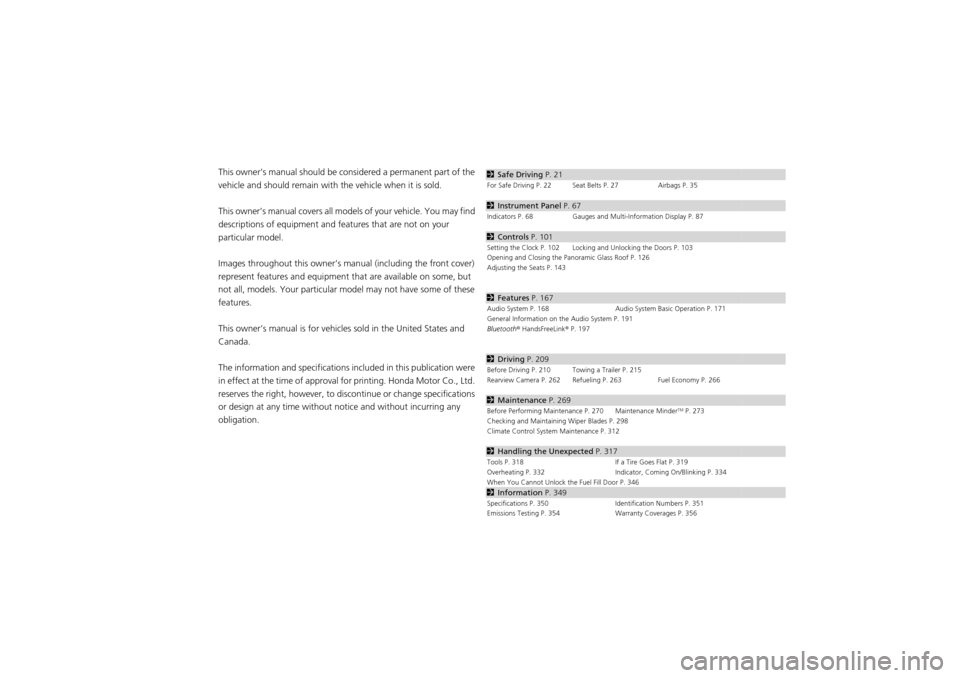
This owner’s manual should be considered a permanent part of the
vehicle and should remain with the vehicle when it is sold.
This owner’s manual covers all models of your vehicle. You may find
descriptions of equipment and features that are not on your
particular model.
Images throughout this owner’s manual (including the front cover)
represent features and equipment that are available on some, but
not all, models. Your particular mo del may not have some of these
features.
This owner’s manual is for vehicles sold in the United States and
Canada.
The information an d specifications included in this publication were
in effect at the time of approval for printing. Honda Motor Co., Ltd.
reserves the right, however, to di scontinue or change specifications
or design at any time without notice and without incurring any
obligation.2 Safe Driving P. 21For Safe Driving P. 22 Seat Belts P. 27 Airbags P. 35
2Instrument Panel P. 67Indicators P. 68 Gauges and Multi-Information Display P. 87
2Controls P. 101Setting the Clock P. 102 Locking and Unlocking the Doors P. 103
Opening and Closing the Panoramic Glass Roof P. 126
Adjusting the Seats P. 143
2Features P. 167Audio System P. 168 Audio System Basic Operation P. 171
General Information on the Audio System P. 191
Bluetooth ® HandsFreeLink ® P. 197
2 Driving P. 209Before Driving P. 210 Towing a Trailer P. 215
Rearview Camera P. 262 Refueling P. 263 Fuel Economy P. 266
2Maintenance P. 269Before Performing Maintenance P. 270 Maintenance MinderTM P. 273
Checking and Maintaining Wiper Blades P. 298
Climate Control System Maintenance P. 312
2 Handling the Unexpected P. 317Tools P. 318 If a Tire Goes Flat P. 319
Overheating P. 332 Indicator, Coming On/Blinking P. 334
When You Cannot Unlock the Fuel Fill Door P. 346
2 Information P. 349Specifications P. 350 Identification Numbers P. 351
Emissions Testing P. 354 Warranty Coverages P. 356
Page 18 of 370
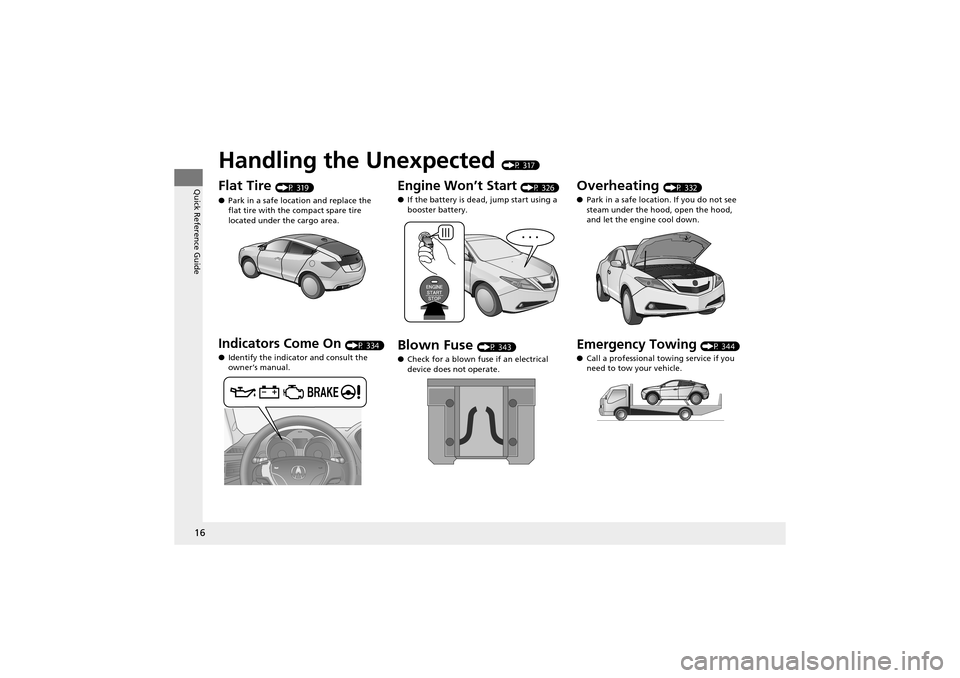
16
Quick Reference Guide
Handling the Unexpected (P 317)
Flat Tire (P 319)
● Park in a safe location and replace the
flat tire with the compact spare tire
located under the cargo area.
Indicators Come On (P 334)
● Identify the indicator and consult the
owner’s manual.
Engine Won’t Start (P 326)
● If the battery is dead, jump start using a
booster battery.
Blown Fuse (P 343)
● Check for a blown fuse if an electrical
device does not operate.
Overheating (P 332)
● Park in a safe locati on. If you do not see
steam under the hood, open the hood,
and let the engine cool down.
Emergency Towing (P 344)
● Call a professional towing service if you
need to tow your vehicle.
Page 83 of 370
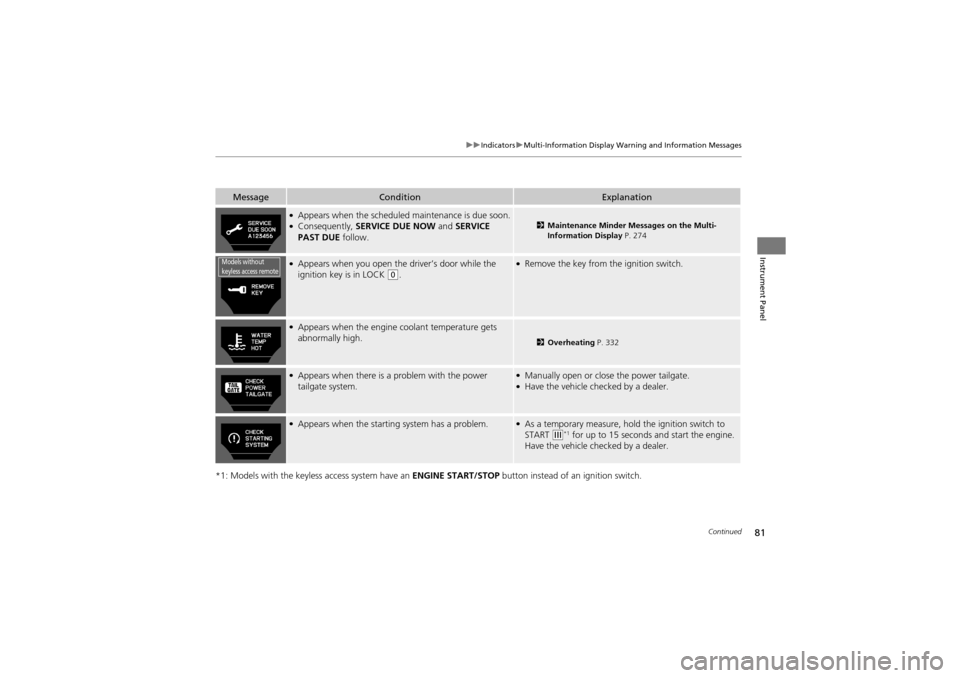
81
uuIndicators uMulti-Information Display Warning and Information Messages
Continued
Instrument Panel
*1: Models with the keyless access system have an ENGINE START/STOP button instead of an ignition switch.
MessageConditionExplanation
●Appears when the scheduled maintenance is due soon.●Consequently, SERVICE DUE NOW and SERVICE
PAST DUE follow.2Maintenance Minder Messages on the Multi-
Information Display P. 274
●Appears when you open the driver’s door while the
ignition key is in LOCK (0.
●Remove the key from the ignition switch.
●Appears when the engine coolant temperature gets
abnormally high.
2 Overheating P. 332
●Appears when there is a problem with the power
tailgate system.●Manually open or close the power tailgate.●Have the vehicle ch ecked by a dealer.
●Appears when the starting system has a problem.●As a temporary measure, hold the ignition switch to
START (e*1 for up to 15 seconds and start the engine.
Have the vehicle ch ecked by a dealer.
Models without
keyless access remote
Page 89 of 370
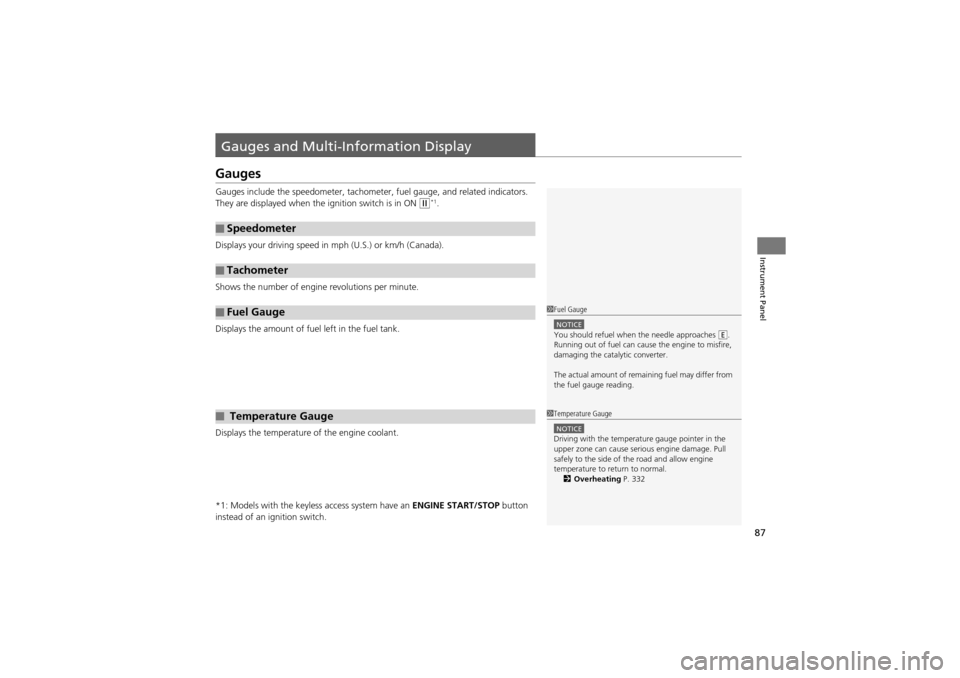
87
Instrument Panel
Gauges and Multi-Information Display
Gauges
Gauges include the speedometer, tachometer, fuel gauge, and related indicators.
They are displayed when the ignition switch is in ON
w*1.
Displays your driving speed in mph (U.S.) or km/h (Canada).
Shows the number of engine revolutions per minute.
Displays the amount of fuel left in the fuel tank.
Displays the temperature of the engine coolant.
*1: Models with the keyless access system have an ENGINE START/STOP button
instead of an ig nition switch.
■Speedometer
■Tachometer
■Fuel Gauge
■ Temperature Gauge
1Fuel Gauge
NOTICEYou should refuel when the needle approaches .
Running out of fuel can cause the engine to misfire,
damaging the catalytic converter.
The actual amount of rema ining fuel may differ from
the fuel gauge reading.E
1 Temperature Gauge
NOTICEDriving with the temperature gauge pointer in the
upper zone can cause serious engine damage. Pull
safely to the side of the road and allow engine
temperature to return to normal.
2 Overheating P. 332
Page 139 of 370
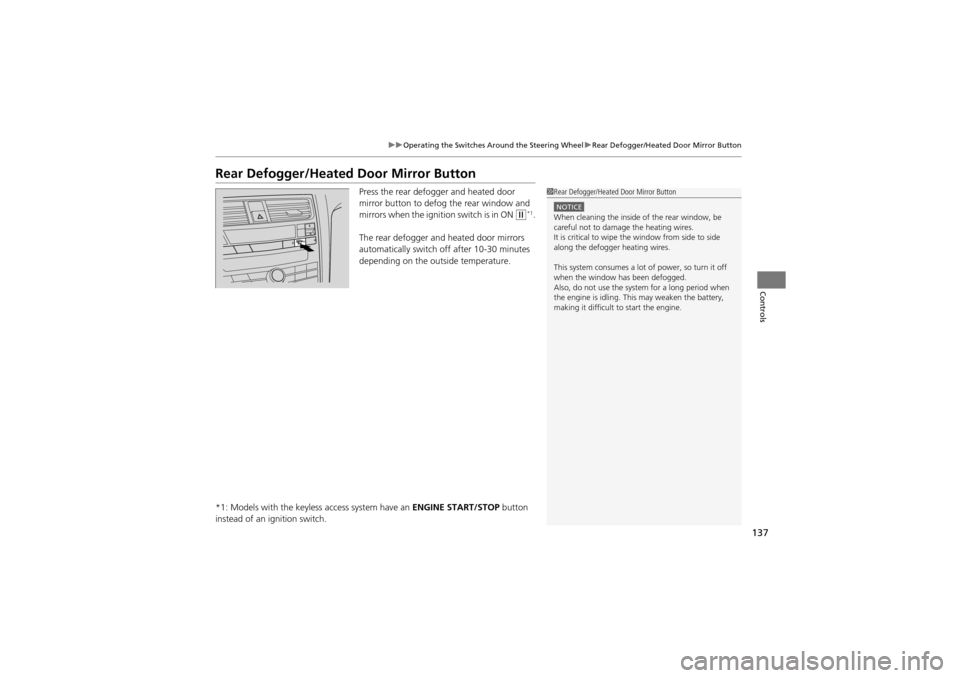
137
uuOperating the Switches Around the Steering Wheel uRear Defogger/Heated Door Mirror Button
Controls
Rear Defogger/Heated Door Mirror Button
Press the rear defogger and heated door
mirror button to defog the rear window and
mirrors when the igniti on switch is in ON
w*1.
The rear defogger and heated door mirrors
automatically switch of f after 10-30 minutes
depending on the outside temperature.
*1: Models with the keyless access system have an ENGINE START/STOP button
instead of an ig nition switch.
1Rear Defogger/Heated Door Mirror Button
NOTICEWhen cleaning the inside of the rear window, be
careful not to damage the heating wires.
It is critical to wipe the window from side to side
along the defogger heating wires.
This system consumes a lot of power, so turn it off
when the window has been defogged.
Also, do not use the system for a long period when
the engine is idling. This may weaken the battery,
making it difficult to start the engine.
Page 302 of 370

300
Maintenance
Checking and Maintaining Tires
Checking Tires
To safely operate your vehicle, your tires must be of the proper type and size, in
good condition with adequate tread, and properly inflated.
■Inflation guidelines
Properly inflated tires provide the best comb ination of handling, tread life, and comfort.
Refer to the driver’s doorjamb label or spec ification’s page for the specified pressure.
Underinflated tires wear unevenly, adversel y affect handling and fuel economy, and
are more likely to fail from overheating.
Overinflated tires make your vehicle ride ha rshly, are more prone to road hazards,
and wear unevenly.
Every day before you drive, look at each of the tires. If one looks lower than the
others, check the pressu re with a tire gauge.
At least once a month or before long trip s, use a gauge to measure the pressure in
all tires, including the spare. Even tires in good condition can lose 1 to 2 psi (10 to
20 kPa, 0.1 to 0.2 kgf/cm
2) per month.
■Inspection guidelines
Every time you check inflation, also examine the tires and valve stems.
Look for:
• Bumps or bulges on the side or in the tread. Replace the tire if you find any cuts,
splits, or cracks in the si de of the tire. Replace it if you see fabric or cord.
• Remove any foreign objects and inspect for air leaks.
• Uneven tread wear. Have a deal er check the wheel alignment.
• Excessive tread wear.
2 Wear Indicators P. 305
•Cracks or other damage around valve stem.
1Checking Tires
Measure the air pressure when tires are cold. This means
the vehicle has been parked for at least three hours, or
driven less than 1 mile (1.6 km). If necessary, add or
release air until the specified pressure is reached.
If checked when hot, tire pressure can be as much as
4–6 psi (30–40 kPa, 0.3–0.4 kgf/cm
2) higher than if
checked when cold.
Have a dealer check the tires if you feel a consistent
vibration while driving. New tires and any that have
been removed and reinstalled should be properly
balanced.
High speed driving
We recommend that you do not drive faster than the
posted speed limits and conditions allow. If you drive
at sustained high speeds (over 99 mph or 160 km/h),
adjust the cold tire pressures as shown below to
avoid excessive heat build up and sudden tire failure.
3WARNING
Using tires that are excessively worn or
improperly inflated can cause a crash in
which you can be seriously hurt or killed.
Follow all instructions in this owner’s
manual regarding tire inflation and
maintenance.
Tire SizeP255/50R19 103H
Pressure (front) 33 psi (227 kPa, 2.3 kgf/cm2)
Page 314 of 370
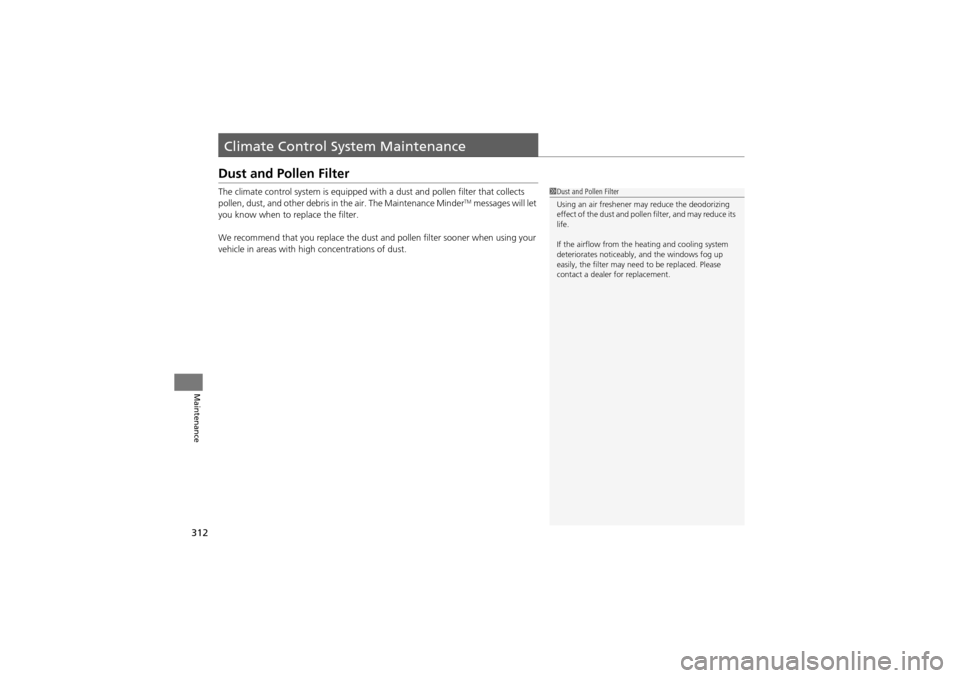
312
Maintenance
Climate Control System Maintenance
Dust and Pollen Filter
The climate control system is equipped with a dust and pollen filter that collects
pollen, dust, and other debris in the air. The Maintenance MinderTM messages will let
you know when to replace the filter.
We recommend that you replace the dust a nd pollen filter sooner when using your
vehicle in areas with high concentrations of dust.
1 Dust and Pollen Filter
Using an air freshener may reduce the deodorizing
effect of the dust and pollen filter, and may reduce its
life.
If the airflow from the heating and cooling system
deteriorates noticeably, and the windows fog up
easily, the filter may need to be replaced. Please
contact a dealer for replacement.
Page 319 of 370
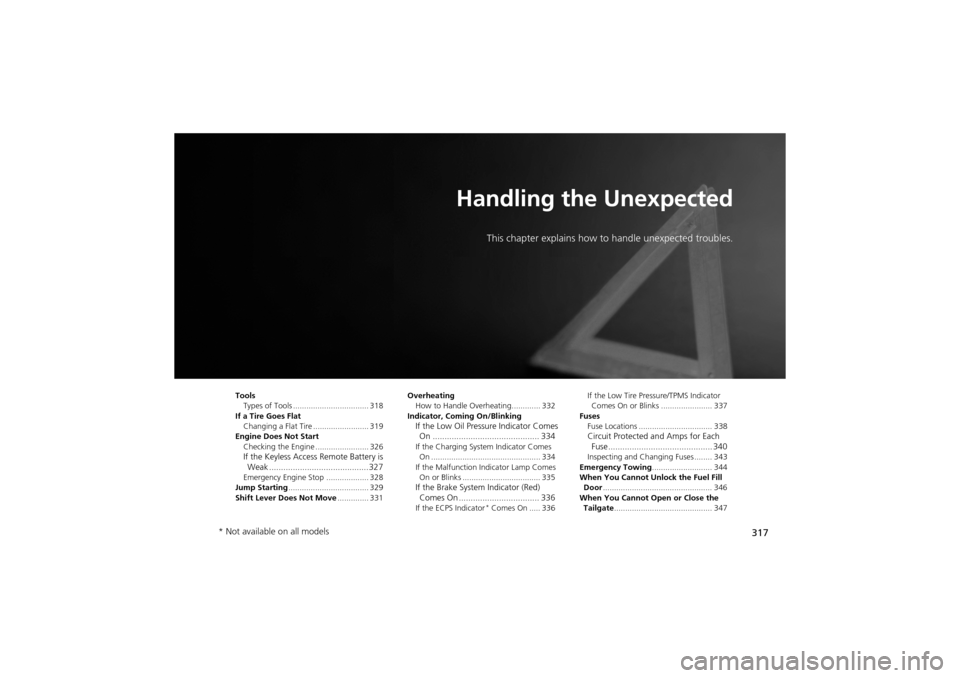
317
Handling the Unexpected
This chapter explains how to handle unexpected troubles.
Tools
Types of Tools .................................. 318
If a Tire Goes Flat Changing a Flat Tire ......................... 319
Engine Does Not Start
Checking the Engine ........................ 326
If the Keyless Access Remote Battery is Weak ..........................................327
Emergency Engine Stop ................... 328
Jump Starting .................................... 329
Shift Lever Do es Not Move.............. 331 Overheating
How to Handle Overheating............. 332
Indicator, Coming On/Blinking
If the Low Oil Pressure Indicator Comes On ............................................. 334
If the Charging System Indicator Comes
On ................................................. 334
If the Malfunction Indicator Lamp Comes On or Blinks ................................... 335
If the Brake System Indicator (Red) Comes On .................................. 336
If the ECPS Indicator* Comes On ..... 336 If the Low Tire Pres
sure/TPMS Indicator
Comes On or Blinks ....................... 337
Fuses Fuse Locations ................................. 338
Circuit Protected and Amps for Each Fuse............................................ 340
Inspecting and Changing Fuses ........ 343
Emergency Towing ........................... 344
When You Cannot Unlock the Fuel Fill Door ................................................. 346
When You Cannot Open or Close the Tailgate ............................................ 347
* Not available on all models
Page 334 of 370
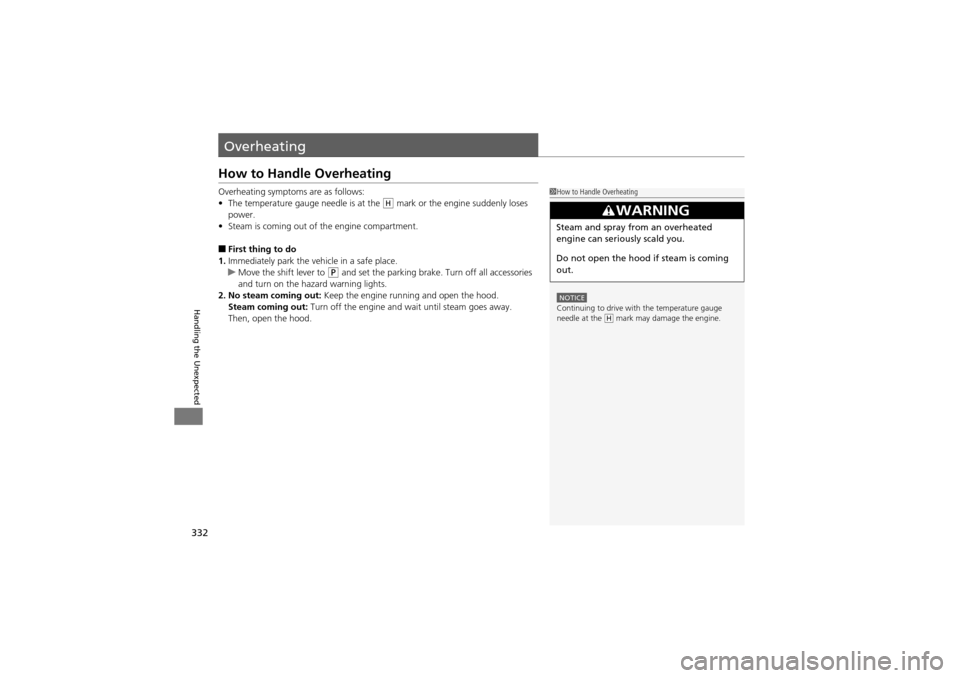
332
Handling the Unexpected
Overheating
How to Handle Overheating
Overheating symptoms are as follows:
•The temperature gauge needle is at the mark or the engine suddenly loses
power.
• Steam is coming out of the engine compartment.
■First thing to do
1. Immediately park the vehicle in a safe place.
u Move the shift lever to
P and set the parking brake. Turn off all accessories
and turn on the hazard warning lights.
2. No steam coming out: Keep the engine running and open the hood.
Steam coming out: Turn off the engine and wait until steam goes away.
Then, open the hood.
1 How to Handle Overheating
NOTICEContinuing to drive with the temperature gauge
needle at the mark may damage the engine.
3WARNING
Steam and spray from an overheated
engine can seriously scald you.
Do not open the hood if steam is coming
out.
H
H
Page 335 of 370
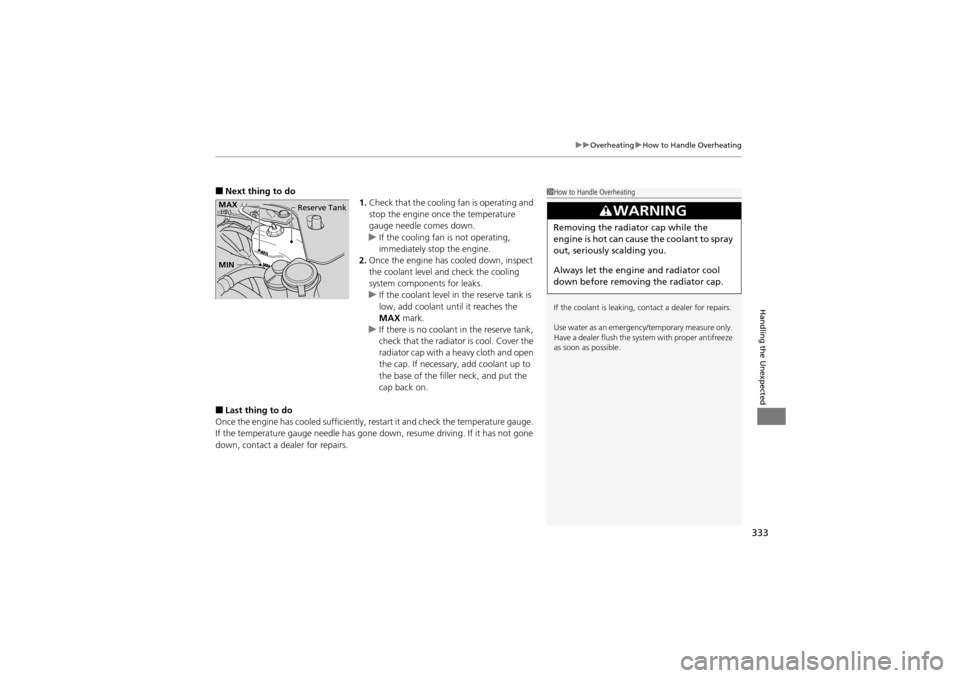
333
uuOverheating uHow to Handle Overheating
Handling the Unexpected
■Next thing to do
1.Check that the cooling fan is operating and
stop the engine once the temperature
gauge needle comes down.
u If the cooling fan is not operating,
immediately stop the engine.
2. Once the engine has cooled down, inspect
the coolant level and check the cooling
system components for leaks.
u If the coolant level in the reserve tank is
low, add coolant until it reaches the
MAX mark.
u If there is no coolant in the reserve tank,
check that the radiator is cool. Cover the
radiator cap with a heavy cloth and open
the cap. If necessary, add coolant up to
the base of the filler neck, and put the
cap back on.
■Last thing to do
Once the engine has cooled sufficiently, restart it and check the temperature gauge.
If the temperature gauge needle has gone down, resume driving. If it has not gone
down, contact a dealer for repairs.
1 How to Handle Overheating
If the coolant is leaking, contact a dealer for repairs.
Use water as an emergency/temporary measure only.
Have a dealer flush the syst em with proper antifreeze
as soon as possible.
3WARNING
Removing the radiator cap while the
engine is hot can cause the coolant to spray
out, seriously scalding you.
Always let the engine and radiator cool
down before removing the radiator cap.
MAX Reserve Tank
MIN